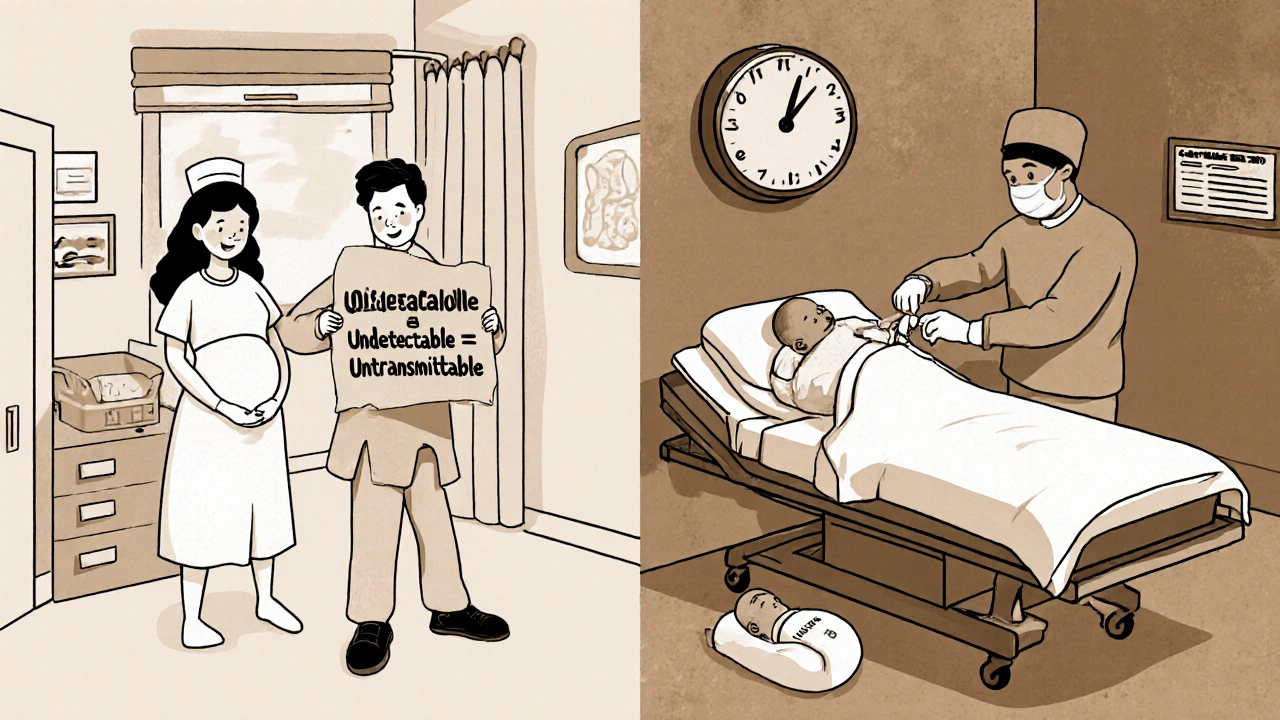HIV Pregnancy Risk Calculator
This tool helps understand your HIV transmission risk during pregnancy based on viral load measurements. Remember: Always consult your healthcare provider for personalized medical advice.
Typically <50 copies/mL is considered undetectable
When a person living with HIV dreams of starting a family, the first question is often: HIV pregnancy can be safe? The short answer is yes-modern medicine makes it possible to have a healthy baby while keeping both mother and child safe. This guide walks you through everything you need to know, from pre‑conception steps to postpartum care, so you can plan with confidence.
Understanding HIV and Pregnancy
Human Immunodeficiency Virus (HIV a virus that attacks the immune system, specifically CD4 cells, leading to potential immune deficiency if untreated) does not stop you from becoming pregnant. What matters is how well the virus is controlled. Two key markers-viral load the amount of HIV RNA in the blood, measured in copies per milliliter and CD4 count the number of CD4 lymphocytes per microliter, indicating immune strength-guide treatment decisions and transmission risk.
When a pregnant person maintains an undetectable viral load (often<50copies/mL) throughout pregnancy, the chance of passing the virus to the baby drops below 1%. This is the cornerstone of the “U=U” principle (Undetectable = Untransmittable) applied to pregnancy.
Pre‑Conception Planning
Before trying to conceive, schedule a comprehensive appointment with an obstetrician‑gynecologist who has experience with HIV. They’ll review your current antiretroviral therapy a combination of medicines that suppress HIV replication and keep viral load low regimen, check for drug interactions, and assess organ function.
- Aim for at least six months of stable, undetectable viral load before conception.
- Update vaccinations (influenza, Tdap, hepatitis B) - some live vaccines are contraindicated once pregnant.
- Screen for co‑infections such as hepatitis C, syphilis, and tuberculosis; treat as needed.
- Discuss fertility options, including timing, ovulation tracking, and assisted reproductive technologies if required.
Nutrition matters, too. A diet rich in protein, iron, folic acid, and omega‑3 fatty acids supports both maternal health and fetal development. If you smoke or use recreational drugs, seek cessation support-these habits raise viral load and pregnancy complications.
Antiretroviral Therapy During Pregnancy
Most modern regimens are safe for pregnancy, but some drugs cross the placenta more readily. The preferred backbone includes two nucleoside reverse transcriptase inhibitors (NRTIs) such as tenofovir disoproxil fumarate/emtricitabine, paired with a third agent like dolutegravir or raltegravir.
Why the specific choice matters:
- Dolutegravir offers rapid viral suppression, which is vital if you start therapy after conception.
- Ritonavir‑boosted protease inhibitors (e.g., lopinavir/ritonavir) are alternatives when integrase inhibitors aren’t tolerated.
Close monitoring is essential. Blood tests for viral load and CD4 count are done each trimester. If viral load spikes, clinicians may intensify therapy or adjust dosing.
Monitoring and Managing Mother‑to‑Child Transmission (MTCT)
Mother‑to‑child transmission (MTCT) is the primary concern. Systematic prevention includes three pillars:
- Maternal viral suppression through effective ART.
- Intrapartum prophylaxis - a single dose of antiretroviral (e.g., zidovudine) given during labor.
- Neonatal prophylaxis - infants receive antiretroviral drugs for the first 4-6 weeks after birth.
Testing the infant’s HIV status occurs at birth, 2 weeks, 1 month, and 4-6 months using PCR assays. Early detection enables prompt treatment, which dramatically improves outcomes.

Delivery Options: Vaginal Birth vs. Scheduled Cesarean
The choice of delivery method hinges on viral load at delivery. When the viral load is <50copies/mL, a vaginal birth is generally safe. However, if the viral load exceeds 1,000copies/mL, many guidelines recommend a scheduled Cesarean delivery a surgical procedure to deliver the baby through an incision in the abdomen, performed before labor begins to reduce MTCT risk at 38weeks.
| Method | Transmission Risk (if viral load <50copies/mL) | Typical Recovery Time | When It’s Recommended |
|---|---|---|---|
| Vaginal birth | ≈0.1% | 6‑8weeks | Undetectable viral load, no obstetric contraindications |
| Scheduled Cesarean | ≈0.2‑0.3% | 8‑12weeks | Viral load >1,000copies/mL, or obstetric reasons |
Regardless of method, avoid prolonged rupture of membranes and invasive fetal monitoring, as these can increase exposure.
Postpartum Care and Infant Prophylaxis
After delivery, the mother continues ART without interruption. Breastfeeding decisions depend on local guidelines; in the UK, the recommendation is to avoid breastfeeding when HIV‑positive, because even with undetectable viral load, a small transmission risk remains (≈0.5%).
For infants, the standard is a 6‑week course of daily nevirapine (or zidovudine if the mother was on a zidovine‑based regimen). Regular follow‑up visits include growth monitoring, vaccination updates, and repeat HIV PCR testing at 4-6weeks.
Partner Involvement and Family Planning
Keeping the partner in the loop builds a supportive environment. If the partner is HIV‑negative, discuss pre‑exposure prophylaxis a daily pill (e.g., tenofovir/emtricitabine) taken by HIV‑negative individuals to prevent infection. Consistent condom use, especially during attempts to conceive, adds another layer of protection.
Long‑acting reversible contraceptives (LARC) like intrauterine devices can be used after delivery if you wish to space pregnancies. When ready for another child, repeat the pre‑conception checklist-viral suppression, medication review, and health optimization.

Common Concerns and Practical Tips
- Can I get sick from my baby’s antiretroviral pills? No-infant doses are tiny and pose no risk to caregivers.
- What if I miss a dose of ART? Take the missed dose as soon as you remember unless it’s close to the next scheduled dose; then skip and resume normal schedule. Contact your provider for guidance.
- Is it safe to travel during pregnancy? Yes, provided you keep medication on hand, stay hydrated, and avoid high‑risk areas for infections.
Quick Checklist for a Healthy HIV Pregnancy
- Maintain undetectable viral load for ≥6months before trying to conceive.
- Attend all prenatal appointments and get viral load tested each trimester.
- Use the recommended ART regimen; discuss any side‑effects promptly.
- Plan delivery method based on viral load at 36weeks.
- Provide infant prophylaxis immediately after birth and follow up with PCR testing.
- Avoid breastfeeding if local guidelines advise; consider formula feeding.
- Engage partner in prevention strategies (PrEP, condom use).
Frequently Asked Questions
Can an HIV‑positive mother have a completely healthy baby?
Yes. When the mother’s viral load is undetectable throughout pregnancy and appropriate prophylaxis is given to the infant, the risk of transmission is below 1%, and most babies are born healthy.
Do I need to change my ART regimen when I become pregnant?
Most modern regimens are safe, but your doctor may swap drugs that have known pregnancy risks (e.g., efavirenz) for safer alternatives like dolutegravir or raltegravir.
Is a scheduled C‑section always required for HIV‑positive mothers?
No. If your viral load is <50copies/mL near delivery, many guidelines allow vaginal birth. A C‑section is recommended when the viral load is high or obstetric issues exist.
Can I breastfeed while on ART?
In the UK the advice is to avoid breastfeeding if you are HIV‑positive, even with undetectable viral load, because a small transmission risk remains.
What should I do if I miss a dose of my infant’s prophylaxis?
Contact your pediatrician immediately. Usually, you’ll be instructed to give the missed dose if it’s within 12hours, then continue the regular schedule.


Murhari Patil
They say modern medicine has solved everything but the shadows whisper that hidden agendas linger in every prescription. The truth about HIV and pregnancy is a fragile thread you must hold tight. Trust not only the labs but also the unseen hands guiding the data. Keep your eyes open.
Danielle Greco
Wow, this guide is like a breath of fresh air! 🌟 The way it breaks down viral load and CD4 counts is super clear, and I love the positive vibe. Keep spreading the good word! 😊
Linda van der Weide
Considering the intertwining of health and hope, one might view pregnancy with HIV as a dialogue between resilience and science. It’s a reminder that life persists even when challenges arise.
Annie Thompson
First, the journey begins before conception with careful consultation and testing It is essential to understand your viral load and to aim for undetectable levels The medical community provides antiretroviral therapy that can dramatically lower the risk of transmission during pregnancy The commitment to medication adherence becomes a daily ritual that shapes the entire pregnancy experience Many women find strength in community support groups where stories are shared and hope is cultivated The psychological aspect cannot be ignored as fear and stigma often linger in the background The placenta, a remarkable organ, does not act as a barrier for HIV but proper treatment protects the fetus The timing of medication adjustments is crucial and must be monitored by an experienced obstetrician The mode of delivery, whether vaginal or cesarean, is decided based on the mother's viral load at term The newborn will receive prophylactic antiretroviral medication shortly after birth to further reduce any chance of infection Breastfeeding decisions are guided by the mother's viral suppression status and local guidelines The postpartum period includes continued therapy for the mother to maintain health and to prevent transmission in future pregnancies The bond that forms between parent and child is nurtured by the knowledge that every precaution has been taken The healthcare system's role is to provide clear information and compassionate care The journey, though complex, demonstrates the power of modern medicine and human determination The story continues as more families thrive and share their experiences with confidence
Dawna Rand
Hey there! 🌈 You’re doing an amazing job gathering the facts, and every step you take makes a world of difference. Remember, your health journey is also a cultural story of strength-keep shining! ✨
Effie Chen
It’s inspiring how each piece of information weaves together a tapestry of empowerment for families. 🌱
ruth purizaca
Another generic guide, nothing new.
Shelley Beneteau
While the content may feel familiar, the clarity on viral load thresholds can still be valuable for those just starting their research.
Sonya Postnikova
Absolutely love how thorough this piece is! 🎉 The blend of medical facts with caring advice makes it both informative and comforting. Great job!
Anna Zawierucha
Oh sure, because a few bullet points magically erase years of stigma-how uplifting.
Mary Akerstrom
Every family deserves this kind of clear guidance it builds confidence and community